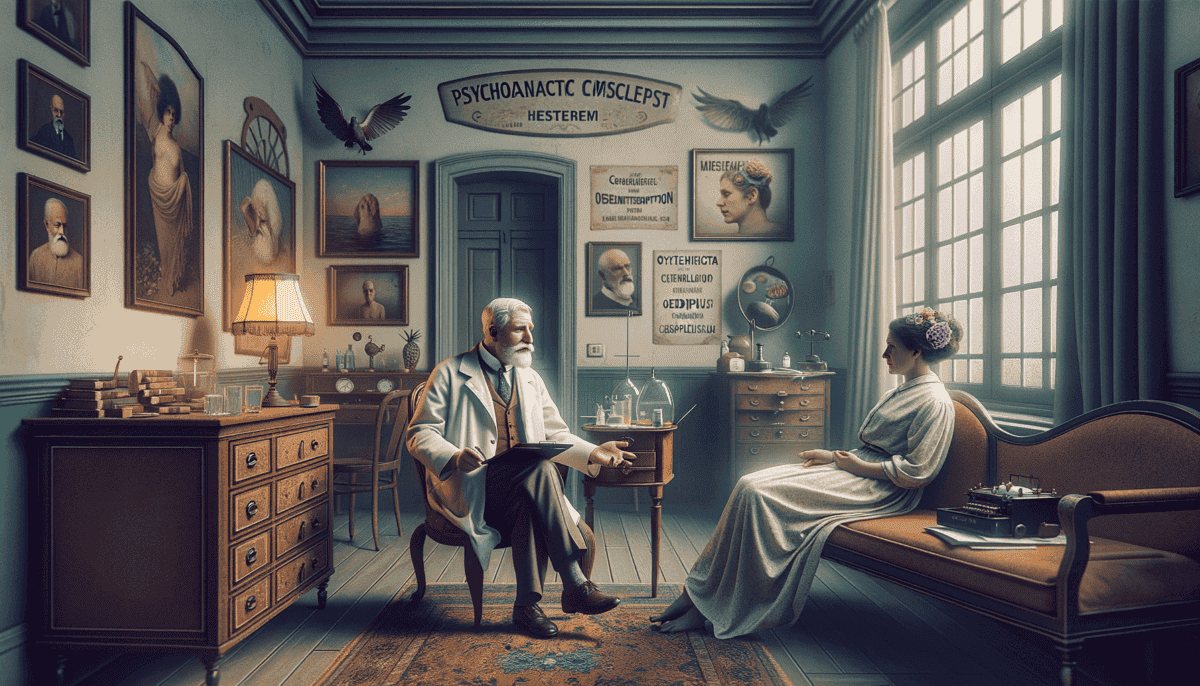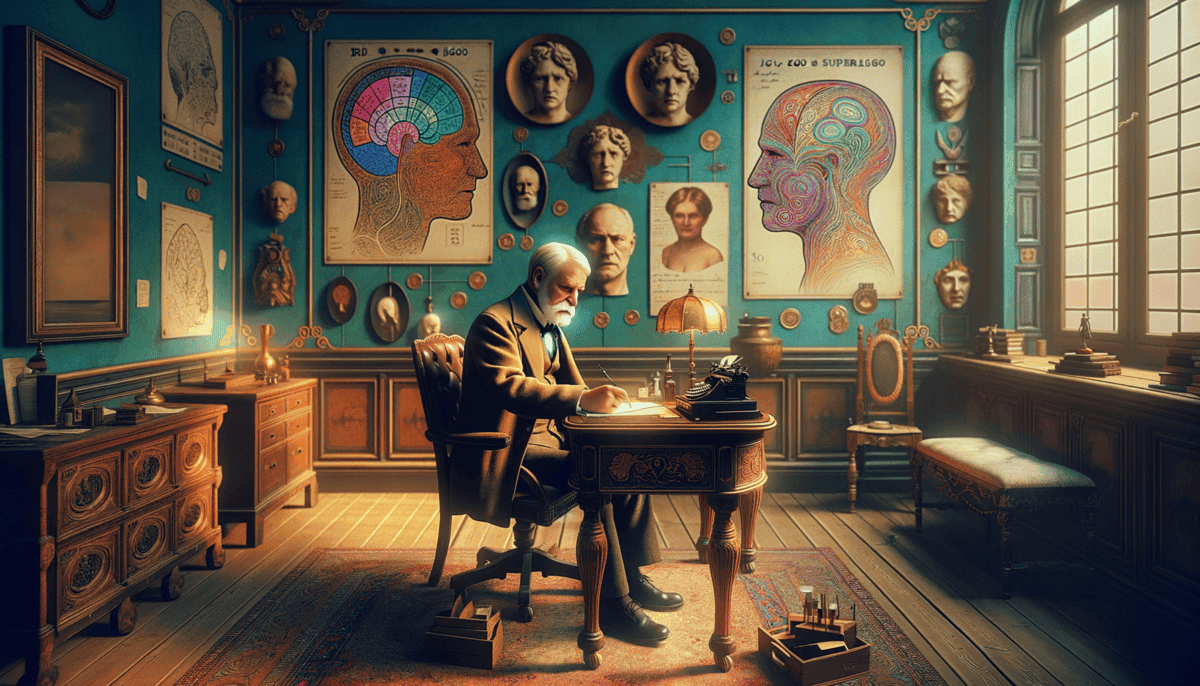The Curious Young Mind
In a cozy house in Vienna, a little boy named Sigmund sat by his window, watching people walk by on the busy street below. It was 1860, and six-year-old Sigmund Freud had many questions about why people did the things they did.
“Mama,” young Sigmund asked one day, “why does Mr. Weber always talk to himself when he walks to the bakery?”
His mother smiled and ruffled his hair. “People are like puzzles, dear. Each one is special in their own way.”
Sigmund liked that idea. He started keeping a small notebook where he wrote down the funny things he noticed about people. His family thought it was cute, but they didn’t know this little hobby would change how we think about our minds forever! ✍️
School Days and Big Dreams
School wasn’t always easy for young Sigmund. Math made his head hurt, and sometimes the other kids made fun of him because he asked so many questions. But that didn’t stop him!
“I want to understand why people feel sad or happy,” Sigmund told his teacher. “I want to help them feel better.”
His teacher saw something special in him. “You have a gift, Sigmund. You notice things others don’t see.”
A Special Discovery
One rainy afternoon, Sigmund found an old book about dreams in his father’s study. His eyes grew wide as he flipped through the pages. What if dreams meant something important? What if they were like secret messages from our minds?
“Papa,” he asked, “do you think our dreams tell us things about ourselves?”
His father laughed kindly. “That’s quite a big thought for such a little boy!”
But Sigmund wasn’t just any little boy. He was different. While other kids played with toys, he played with ideas. He watched. He listened. He thought about things that most people ignored.
The First Steps
As Sigmund grew older, his questions got bigger. He started noticing that people often did things without knowing why they did them. Like his sister, who always tapped her spoon three times before eating soup, or his friend who whistled when he was nervous.
One night, as he lay in bed, young Sigmund made a promise to himself. He would find out why people act the way they do. He would help them understand themselves better.
Little did he know, this curious young boy would grow up to change how we think about our minds forever. His questions would lead to amazing discoveries about how our brains work, and why we do the things we do.
As the stars twinkled outside his window, Sigmund smiled. He had so many more questions to ask, so many more things to learn. And this was just the beginning of his amazing journey.
Exploring the Hidden Depths
Young Sigmund grew into a hardworking doctor. He put on his white coat every morning, ready to help sick people feel better. But something kept bothering him.
“There must be something more,” Sigmund said to himself one day while writing in his notebook. “Maybe the problem is hiding somewhere we can’t see.”
A Strange New Idea
One day, Sigmund met a patient named Anna. She couldn’t walk, but her legs were perfectly fine! All the other doctors were confused. ♂️
“Tell me about your feelings,” Sigmund asked Anna gently.
As Anna talked, something amazing happened. She started to remember things she had forgotten. Sad things that made her feel scared. And as she talked about these feelings, her legs began to work again!
“Sometimes,” Sigmund wrote in his diary that night, “our minds hide scary feelings in a special drawer. But talking about them can help open that drawer.”
Making New Friends
Other doctors thought Sigmund’s ideas were silly. But he found some friends who believed in him. One was Dr. Josef Breuer, who liked to help people by letting them talk about their feelings too.
The Secret Garden of the Mind
Sigmund started thinking about the mind like a garden. Some thoughts were like flowers growing in the sunshine – easy to see. But other thoughts were like seeds hiding underground. You couldn’t see them, but they were still there!
He called these hidden thoughts the “unconscious mind.” It was like a special part of our brain that holds secrets we don’t even know about!
Making People Better
Sigmund started helping people in a new way. Instead of giving them medicine, he let them talk. And talk. And talk some more! He found that when people shared their hidden feelings:
- They felt lighter and happier
- Their problems got smaller
- They understood themselves better
- They could solve their own puzzles
Never Giving Up
Even when other doctors laughed at his ideas, Sigmund kept working. He knew in his heart that he was onto something important. Every day, he wrote down what he learned from his patients.
“The mind is like an iceberg,” he told his friends. “We only see a tiny bit floating on top. The biggest part is hidden under the water!”
As more people got better after talking to Sigmund, others started to listen. Maybe this young doctor with wild ideas wasn’t so crazy after all. Maybe he had found a new way to help people feel happy again.
And so, Sigmund kept exploring the hidden parts of people’s minds, like a brave explorer mapping a new world. He didn’t know it yet, but his discoveries would help millions of people understand themselves better.
The Talking Cure Revolution
Sigmund sat in his cozy office, surrounded by books and a special couch where his patients would lie down. He had a new way to help people – by letting them talk about their feelings! ️
A Special New Way
“Just close your eyes,” Sigmund would say kindly, “and tell me whatever pops into your head. Don’t worry if it sounds silly!”
This new way was called “free association.” It was like letting your thoughts flow like a river, without trying to control them.
“Sometimes the most important thoughts are the ones we try to hide,” Sigmund wrote in his notebook. “Like finding treasure in a secret cave!”
Emma’s Story
One day, a lady named Emma came to see Sigmund. She was scared of going to stores, but didn’t know why. As she talked freely about her thoughts:
When Emma remembered this, she started feeling better about going to stores again. It was like finding a lost puzzle piece that made everything make sense!
Hidden Memories
Sigmund discovered something amazing – our minds sometimes hide memories that make us feel scared or sad. He called these “repressed memories.” They’re like toys pushed under the bed – out of sight but still there!
But talking about feelings could help find these hidden memories. And when people found them, they often felt much better! ⭐
Not Everyone Believed
Some doctors didn’t like Sigmund’s new ideas. They thought talking about feelings was silly.
“Real doctors give medicine!” they would say.
But Sigmund knew he was helping people. His patients got better, and that’s what mattered most.
- People felt happier after talking
- They understood their feelings better
- Their problems started getting smaller
- They weren’t as scared anymore
Never Giving Up
Even when things got hard, Sigmund kept working. He had his own worries too – headaches that wouldn’t go away and problems with money. But he didn’t stop helping people.
Growing Stronger
More and more people started coming to see Sigmund. They heard about the doctor who helped people by listening to their stories.
Each person who got better was like a tiny light in the dark. And soon, there were so many lights that even the doctors who didn’t believe had to take notice!
Sigmund’s special way of helping people was growing bigger and stronger. He showed the world that sometimes, the best medicine isn’t medicine at all – it’s having someone listen to your story and understand your feelings.
Every day, he learned more about how our minds work. And every day, he helped more people understand the feelings hiding in their hearts.
Mapping the Mysterious Mind
Sigmund sat at his desk one morning, drawing a special map. But this wasn’t a map of streets or mountains – it was a map of how our minds work!
The Three Parts of Our Mind
“The id is like a tiny baby,” Sigmund would tell his students. “It just wants what it wants right now!”
If you see a cookie and want to grab it without asking, that’s your id talking!
“The ego is like a wise teacher,” he explained. “It helps us follow rules and be good.”
The ego tells you to ask nicely for the cookie instead of grabbing it.
And the superego? “That’s like having a tiny judge in your head,” Sigmund said. “It helps us know right from wrong.” ⚖️
Dreams Tell Stories
One night, a little girl told Sigmund about her dream:
“I dreamed I was flying on a rainbow butterfly!” she said.
Sigmund smiled. “Maybe that means you want to do something brave and beautiful,” he told her.
The Funny Family Feelings
Sigmund noticed something interesting about families. Sometimes little boys want to be just like their dads, and little girls want to be just like their moms.
He called this the Oedipus complex, after an old story. It’s like when kids go through a phase of saying “When I grow up, I want to marry Mommy!” or “Daddy is my hero!”
- Kids learn from watching their parents
- They try to copy grown-up behavior
- These feelings help them learn about love
- Later, they grow out of this phase
Not Everyone Agreed
Some people thought Sigmund’s ideas were strange. “Dreams are just silly pictures in our heads!” they said.
Fighting His Own Battles
While Sigmund was helping others understand their minds, he had his own worries too. Sometimes he felt scared or sad, just like everyone else.
But he used these feelings to learn more. Every time he felt worried or confused, he tried to understand why. This made him an even better doctor!
Sharing His Ideas
Sigmund wrote books about what he learned. He wanted everyone to know that it’s okay to have different feelings, even strange ones.
He taught other doctors too. “Listen to your patients,” he would say. “Their minds are trying to tell them something important!”
Even when other doctors laughed at his ideas, Sigmund kept teaching and learning. He knew that understanding our minds could help make people happier and healthier. ⭐
Each day brought new discoveries about how our minds work. And with each discovery, Sigmund helped more people understand themselves better.
The Growing Storm
The year was 1933, and dark clouds were gathering over Vienna. Sigmund Freud sat in his famous study, surrounded by his beloved books and special artifacts. But things were changing fast. ️
Famous Around the World
“Dr. Freud,” said Anna, his daughter and fellow doctor, “they want you to give more talks in America!”
Sigmund smiled. His ideas about our minds were spreading everywhere. People in far-away places wanted to learn how to help others by listening to their problems.
“When we listen with our hearts,” Sigmund often said, “we can help people feel better.” ❤️
Not Everyone Was Happy
But some doctors didn’t like Sigmund’s new ways of helping people. They thought talking about feelings was silly.
A Scary Time
In Vienna, things were getting scary. Bad people called Nazis were taking over. They didn’t like Sigmund because he was Jewish.
- His books were burned in the streets
- His friends warned him to leave
- Many people helped him escape
- He had to start over in a new country
Finding Safety in London
Sigmund’s friends helped him move to London with his family. He was sad to leave his home, but he knew it wasn’t safe anymore.
“Look, Papa,” said Anna, pointing to their new office. “We can still help people here!”
Fighting Through Pain
“Does it hurt very much?” his friends would ask.
“Yes,” he would say, “but helping people understand their minds hurts less than not helping at all.”
Never Giving Up
Even when he was tired and sick, Sigmund kept writing and teaching. He wanted to make sure his ideas would help people even after he was gone.
“The mind is like a garden,” he told his students. “Sometimes it needs care to grow better.”
More and more doctors started using Sigmund’s ideas. They saw how talking about feelings could help people feel better.
A New Home, Same Mission
In his new London home, Sigmund set up his office just like it was in Vienna. He put his special collection of old statues on the desk and his comfy couch where patients could talk.
“See?” he told Anna. “We can help people anywhere in the world.”
Even with all the hard times, Sigmund kept believing in his work. He knew that understanding our minds was the key to helping people live happier lives.
A Legacy that Changed the World
The sun peeked through the window of Sigmund’s London office one bright morning in 1939. His special collection of ancient statues cast long shadows across his desk.
A Special Visitor
“Dr. Freud,” a young doctor said, stepping into the room. “I came all the way from America to learn from you!” ✈️
Big Changes Everywhere
Sigmund’s ideas were changing how people thought about minds and feelings. Doctors started listening more to their patients. Artists made paintings about dreams. Writers wrote stories about what people think deep inside.
“Every person’s mind is special,” Sigmund would say. “Like a book with many stories inside.”
Helping in New Ways
Anna sat with her father, showing him letters from people they had helped.
“Look, Papa,” she smiled. “They’re feeling better because they learned to understand their feelings!”
A Gift to the Future
Even though Sigmund was very sick, he kept teaching others. He wanted his ideas to help people long after he was gone.
- His books were read in many languages
- Schools taught his ideas to new doctors
- His ways of helping people spread worldwide
- His daughter Anna kept teaching others
Still Helping Today
Today, many years later, Sigmund’s ideas still help people. When someone feels sad or worried, they can talk to a special doctor who uses what Sigmund taught. ️
A Dream Come True
Little Sigmund from Vienna grew up to help millions of people understand their minds better. His curious questions as a boy led to big answers that still matter today.
“Remember,” Anna would tell her students, “my father showed us that everyone’s mind is special and worth understanding.”
The Story Lives On
Sigmund’s life ended in 1939, but his story didn’t stop there. His ideas keep growing and helping people every day.
Just like he wanted, people everywhere now know it’s okay to talk about their feelings. They know that understanding our minds helps us live better lives.
And somewhere, maybe that curious little boy from Vienna is smiling, knowing his questions helped make the world a kinder, more understanding place. ⭐






